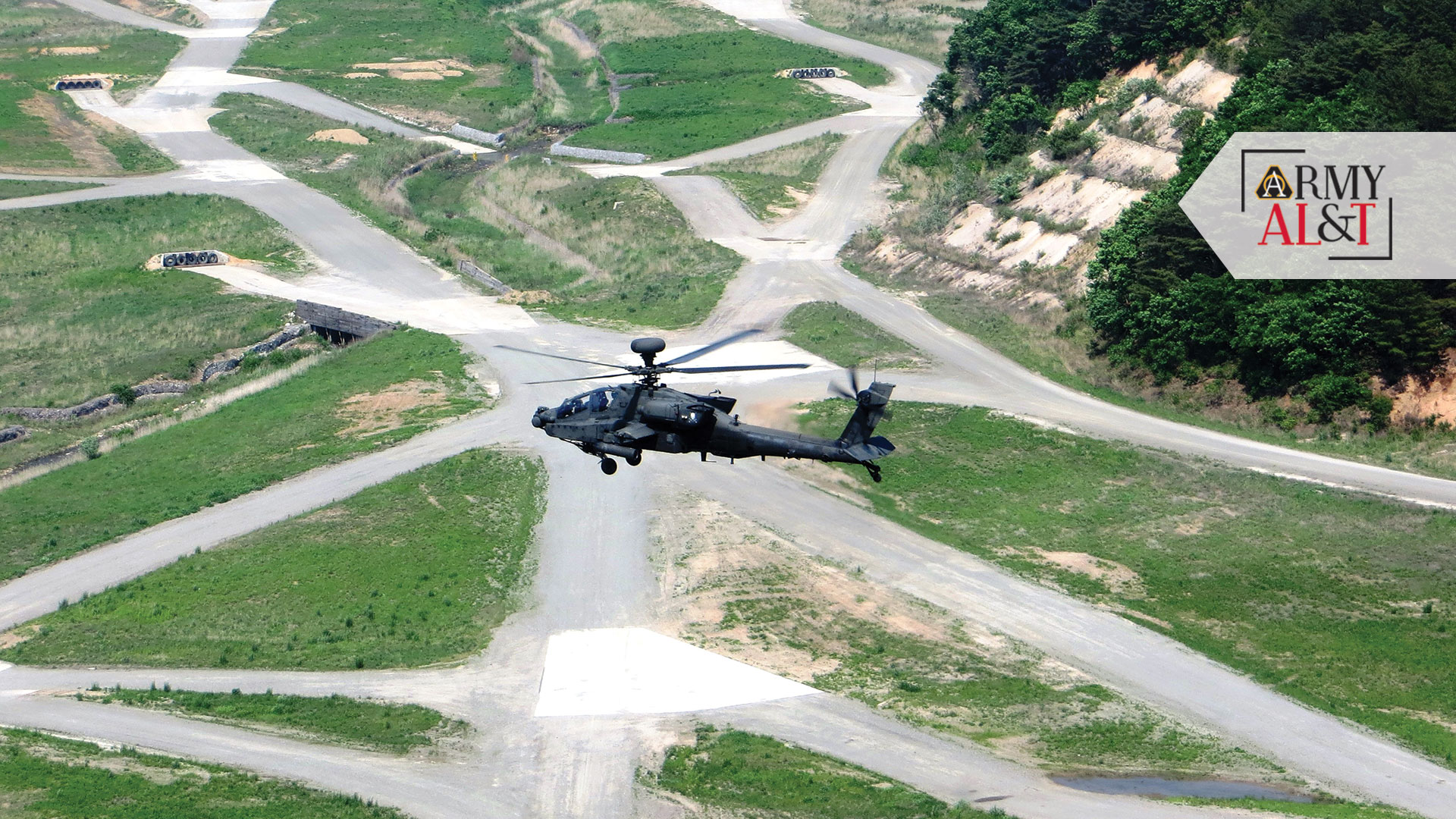
SOLUTION WANTED: Rodriguez Live Fire Complex is a 3,900-acre training area in South Korea. Because of space constraints, errant training rounds are a recurring problem. FAST advisors offered 8th Army a solution that also matured relevant technologies. (Photo by the author)
How U.S. Army Futures Command is going direct to Soldiers around the world, and how it can help your program.
by Lt. Col. Marc Meeker
It happens in nearly every Hollywood action movie: “This is only the prototype. It will outgun [insert bad guy name], but it still has some bugs to work out.”
The movie’s hero inevitably takes the prototype system and uses the new(er) technology to defeat the enemy. Is this just Hollywood fiction, or does the U.S. Army have similar programs that put the newest technology into the hands of Soldiers in the field?
It does. In addition to its nine international technology centers, the U.S. Army Combat Capabilities Development Command (CCDC) has seven Field Assistance in Science and Technology (FAST) teams worldwide, managed by CCDC’s Global Technology Office. With standing positions on the general staffs of U.S. Army Europe and U.S. Forces Korea (among others), these teams offer uniquely direct feedback from Soldiers in the field on developmental systems and technology. The Soldiers and defense acquisition civilians who make up the FAST teams have a two-way mission: Get technology to the field faster, and apprise the Army’s scientists, engineers and requirements writers on what the field commands need.
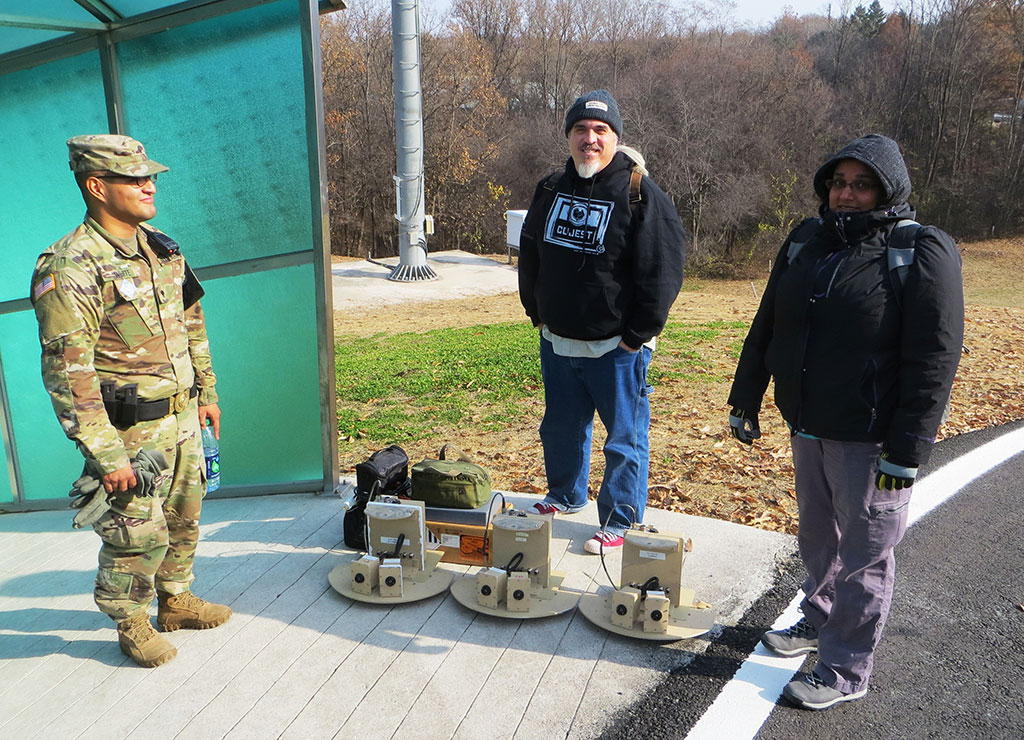
MINIMAL THREAT: Fiona Narayanan and Maxwell Bottiger, engineers from the CCDC Chemical Biological Center who work on threat imaging dual-use aerosol monitoring systems, consult with their escort from the U.N. Military Armistice Commission. The system has the ability to detect chemical agents at a distance. (Photo by the author)
FAST taps directly into the acquisition cycle, essentially expediting the relationship between the warfighter and the materiel developer while supporting the requirements development process. The result is that program managers can put their newest technology into the hands of Soldiers for developmental feedback, or, optimally, provide insight into emerging requirements even before they reach the U.S. Army Training and Doctrine Command’s (TRADOC) centers of excellence, where many program offices have embedded staff members.
Program offices and CCDC engineers have leveraged FAST effectively. The teams that were most successful learned through experience to follow these four guidelines, to get the most out of the opportunity to put technology directly into the hands of Soldiers:
- Have a plan.
- Build consensus.
- Be a part of the bigger picture.
- State the costs and benefits up front.
The following real-life examples illustrate each of these four lessons.
PLAN TO MEET THE NEED: ENHANCED CAMERA
When CCDC chemical and biological engineers approached the FAST team at U.S. Forces Korea (USFK) in April 2016, they were already working with the Joint Program Executive Office for Chemical, Biological, Radiological and Nuclear Defense (JPEO-CBRND) to develop low-cost alternatives to existing standoff detection systems. CCDC’s Chemical Biological Center knew about the persistent threat of nonconventional weapons from North Korea, and standoff detection systems were of great interest to USFK.
What the engineers needed was an operational test to move their work toward transition and integration under JPEO-CBRND’s portfolio. Threat imaging dual-use aerosol monitoring alarms/security represented a low-cost, multicomponent camera that provided infrared and thermal detection. While these capabilities are not new on the battlefield, the subcomponents and algorithms built into the camera system gave it a superpower: the ability to detect chemical agents at a distance.
After developing three prototype systems, the next step was to test the threat-imaging technology in a realistic environment that would challenge its capabilities. Coincidentally, the USFK FAST Office had just received a call from the United Nations multinational battalion at the Demilitarized Zone, seeking assistance in repairing their aging camera system, which was used to provide U.S. and South Korean troops with situational awareness on one of the most fortified borders in the world.
The threat-imaging system would fill this niche requirement perfectly, providing U.S. Soldiers on the front lines with enhanced cameras while allowing a team of engineers to gather valuable data on the system’s operation in a field environment, with complications such as extreme weather, Asia’s famed “yellow dust” and even enemy spoofing attempts. The FAST team took the reins and sought concurrence from USFK’s J-3 (operations), J-8 (budget, requirements, analysis and modernization) and legal offices, as well as the U.N.’s Command Military Armistice Commission. The commission, established in July 1953 at the conclusion of the Korean War, supervises the implementation of the Korean armistice agreement and serves as the higher headquarters of the security battalion at the demilitarized zone.
Navigating this maze of staff offices to install three cameras at the Demilitarized Zone was nearly as challenging as developing the camera system’s detection algorithms. As part of the USFK staff, the FAST team had an optimal view of the path forward and could see the immediate need that had yet to be formalized in requirements circles. Within six months of initiation, the cameras were overlooking the fields of North Korea from a high perch along the Demilitarized Zone, providing U.S. Soldiers with enhanced security.
As with the camera system, FAST advisers actively seek out program management offices, research and engineering centers and even industry to meet established and emerging needs for U.S. Soldiers around the world. No other part of the institutional Army has such a complete network of acquisition-certified, technically capable personnel in place. This network has the potential to deliver prototype technologies that can solve warfighter challenges or have a direct, positive impact on a command’s mission capabilities.
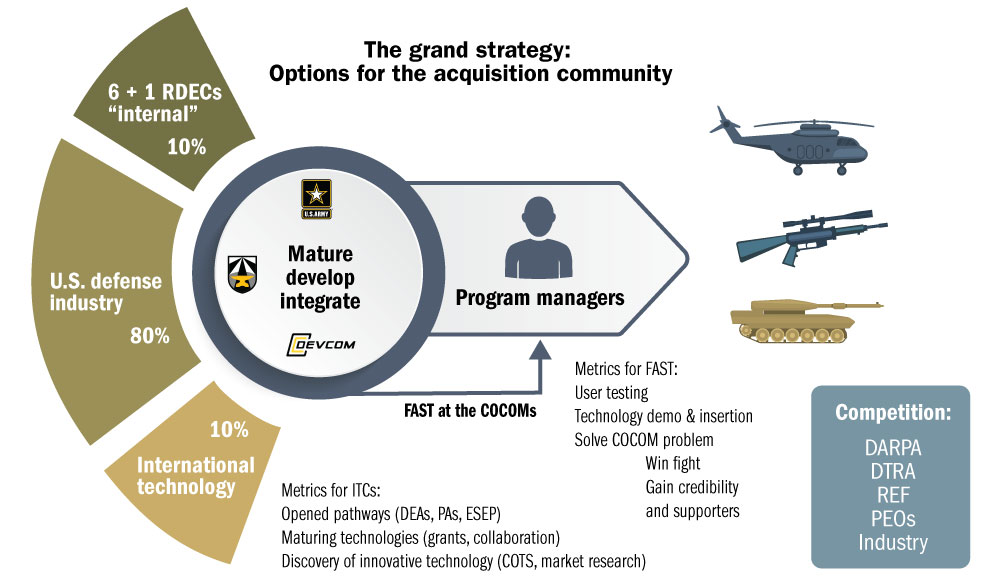
COLLABORATION IS KEY: International technology centers, the CCDC and FAST work together to provide technologies to the program manager.
BUILD CONSENSUS: COMMUNICATIONS WITH LIGHT FIDELITY
The U.S. Army Europe (USAREUR) area of operations has evolved into a rapidly changing and potentially contested environment. In his book “The New Rules of War,” Sean McFate describes countries such as Russia that are “playing by new rules that we have not yet recognized.” McFate asserts that U.S. adversaries take advantage of a tendency of our government to see war as “binary”—either we’re at war or we’re not—by operating below that threshold.
USAREUR has identified multiple ways that adversaries stay beneath that threshold, including interruption of communications through electronic signals disruption. This topic arose during USAREUR leadership engagements in 2017 and 2018, leading the USAREUR G-6 (networks, communication and information security) to initiate a search for improved communications technologies that would help resolve this emerging challenge.
In 2018, the CCDC FAST team at USAREUR queried the command’s Army Research Laboratory and C5ISR Center and returned to USAREUR with details on developmental light fidelity (LiFi) infrared wireless communications technology, capable of sending 600-plus megabits per second in inclement weather, with no residual radio frequency signature. The USAREUR G-6 had heard about this new technology, and working hand in hand with FAST, helped tie in the G-2 (intelligence), G-3 (operations) and other key players, such as the Army Cyber Command liaison, Rapid Equipping Force, USAREUR’s liaisons to TRADOC and the Office of the Assistant Secretary of the Army for Acquisition, Logistics and Technology, and experts from multiple research and development centers within CCDC.
All concurred that this technology had tremendous potential to help USAREUR with emerging requirements. During a windy, rainy week in fall 2019, the FAST team, in conjunction with USAREUR G-6 technical advisors, Soldiers, Army Research Laboratory scientists and C5ISR engineers and contractors, conducted sustained and effective data transfer for a team of visiting leaders that included Lt. Gen. Christopher Cavoli, USAREUR commanding general. By building consensus within USAREUR and with the right points of contact, the FAST team successfully demonstrated a technology that met the emerging needs of the USAREUR command, paving the way for further development of LiFi technologies.
BE PART OF THE BIGGER EFFORT: DEVELOPMENTAL ROBOTICS
The Army has focused doctrine and technology development on multidomain operations, which includes fighting across land, sea, air and cyber. Under the land portion, combatant commands have further emphasized the need for a renewed focus on the megacity challenge, as well as subterranean operations. To this end, CCDC’s Armaments Center established a community of interest to bring requirements writers, materiel developers, scientists, engineers and Army commands together. The Defense Advanced Projects Research Agency (DARPA) has even come to the table with its SubT Challenge. The FAST teams at USAREUR and USFK joined this SubT community in 2015, leveraging it to bring relevant expertise and technology to Soldiers.
The first big victory for this effort was in South Korea, with the Rapid Equipping Force under the Program Executive Office for Soldier procuring specially modified iRobot platforms for subterranean operations. These robots had been developed over more than 10 years in a collaborative effort between DARPA and CCDC’s Ground Vehicle Systems Center (formerly the Tank Automotive Research, Development and Engineering Center), and answered an operational needs statement for the 2nd Infantry Division (2 ID).
Although the first iRobot platforms didn’t transition to a program of record, they paved the way for later developmental programs informed by the work of the SubT community of interest and emerging requirements from 2 ID. Most recently, CCDC FAST at USFK has supported the Coalition Warfare Project Autonomous Tunnel Exploitation, a three-year collaborative effort among the Defense Threat Reduction Agency, CCDC Ground Vehicle Systems Center and South Korea’s Agency for Defense Development.
The tunnel project leverages DOD research and development dollars, along with the technological capabilities of our foreign partners, to meet U.S. Army acquisition goals. In line with the challenges facing the 2 ID, the project aims to integrate autonomous mapping, data teaming, and chemical, biological, radiological and nuclear sensor capabilities to support subterranean operations and address the capability gap for rapidly characterizing and exploiting underground facilities. Further, by tying back to the SubT community of interest and relevant CCDC research and development centers, FAST Korea serves as the bridge between technology development and the emerging requirements of the commanders at 8th Army, 2nd Infantry Division, and Joint United States Military Affairs Group – Korea.
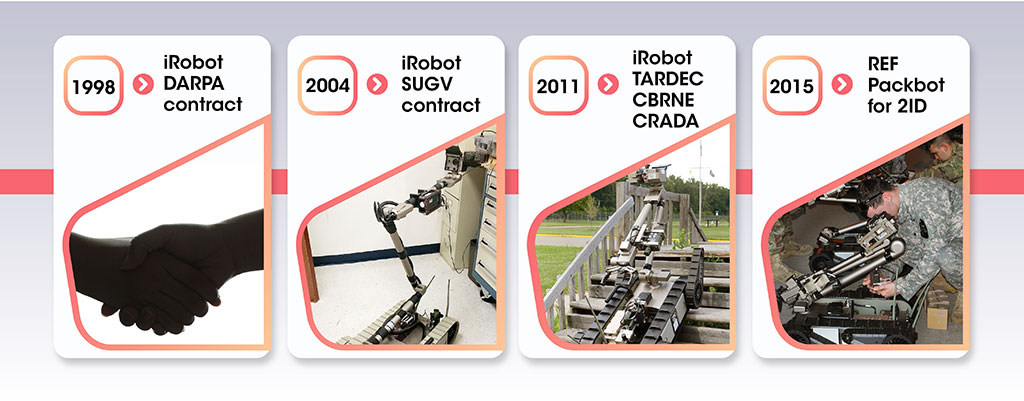
YEARS IN THE MAKING: Specialized robots were developed over more than 10 years in a collaborative effort between DARPA and the CCDC Ground Vehicle Systems Center, and answered an operational needs statement for the 2 ID. (Image by the author.)
STATE THE COSTS UP FRONT: CUAS SUBTECHNOLOGIES
Drones are a force to be reckoned with on present and future battlefields, as evidenced by the recent strike against Iran’s Gen. Qassem Soleimani. U.S. Army commands around the world have been asking aggressively for counter-unmanned aerial system (CUAS) capabilities.
While many options are in development, no clear leader exists. This is partially because the underpinning technologies for CUAS are in constant evolution. If commanders are made aware of the limitations up front, FAST officers can bring pieces of developmental materiel forward to solve present-day problems, while answering the need for researchers and program offices to conduct operational and limited user testing. This happened in 2016 when 8th Army’s commanding general, Lt. Gen. Thomas Vandal, had to stop live-fire training at the Rodriguez Live Fire Complex for the entire South Korean peninsula because training rounds landed outside of designated impact areas. In conjunction with CCDC’s Armaments Center, the command’s FAST team at USFK offered a potential solution: As part of a developmental CUAS system, the Armaments Center sought a venue to test the PTS-3030 radar in a live-fire environment.
Up front, the costs to the 8th Army command would be a piece of terrain on Rodriguez Range, 24-hour security for the radar system and assistance with the appropriate approvals to have it shipped to South Korea. As a caveat, FAST advisers warned that 8th Army might have to pay for or facilitate shipment of the radar to South Korea. The payoff for the Armaments Center researchers was twofold.
First, Rodriguez Range conducted combined-fires exercises that would see a variety of rounds crossing the radar’s tracking system, which would provide unique data on its ability to “see” UAS through battlefield clutter. In addition, the radar would eventually need to be moved to South Korea as part of a bilateral CUAS developmental agreement. Testing it at the range would solve both problems, as well as provide 8th Army with a way of seeing exactly where training rounds were going. With this knowledge, range procedures and terrain could be examined to (potentially) preclude future out-of-impact-area incidents. The 8th Army commanding general and staff saw this as a solid win, as all they needed to provide was, in essence, paperwork.
The emplacement of the PTS-3030 radar at the Rodriguez Live Fire Complex was just one smart, multipurpose step in a chain of events that are still playing out today. The CUAS also received more than $1 million in DOD Coalition Warfare Program funding, which was extended in 2019. CCDC’s Armaments Center has collaborated with the Project Director for Counter-Rocket, Artillery and Mortar, under the Program Executive Office for Missiles and Space, to mature the effort toward transition, while actively developing subtechnologies with the South Korean Ministry of Defense’s research arm, the Agency for Defense Development. This effort likely would have stopped back in 2016 if the 8th Army hadn’t been informed of the costs up front, allowing it to conduct a well-informed cost-benefit analysis.
CONCLUSION
Program managers and the CCDC researchers who feed the materiel development pipeline are constantly seeking details on what the warfighter wants, while at the same time trying to mature the technologies in their portfolios. CCDC’s FAST teams are ideally positioned to help achieve these goals simultaneously, while providing real-world feedback from the Soldiers within combatant commands and Army service component commands.
By approaching FAST with capable technologies that meet warfighter needs, a program manager can expect assistance in building momentum and consensus toward established goals, from clarifying requirements through maturing technologies, and onward toward low-rate initial production. By tying into greater efforts such as the big six modernization priorities (and subtechnologies), program managers can ensure relevance and assured interest from the commands, facilitated by FAST officers who will regularly assist with communication between the program manager and the respective command. Finally, to garner command sponsorship, it is critical to state the costs up front for an accurate cost-benefit analysis; if, after that analysis, the answer is “no,” then a direction has been chosen, and informed adjustments can be made.
The network of FAST advisers is already established worldwide. Through purposeful planning via CCDC’s Exercise Management Plan, key technologies are being aligned to insert in named exercises and in accordance with established and emerging warfighter requirements. FAST is a critical tool in ensuring relevance and effective development of systems for the Army’s future.
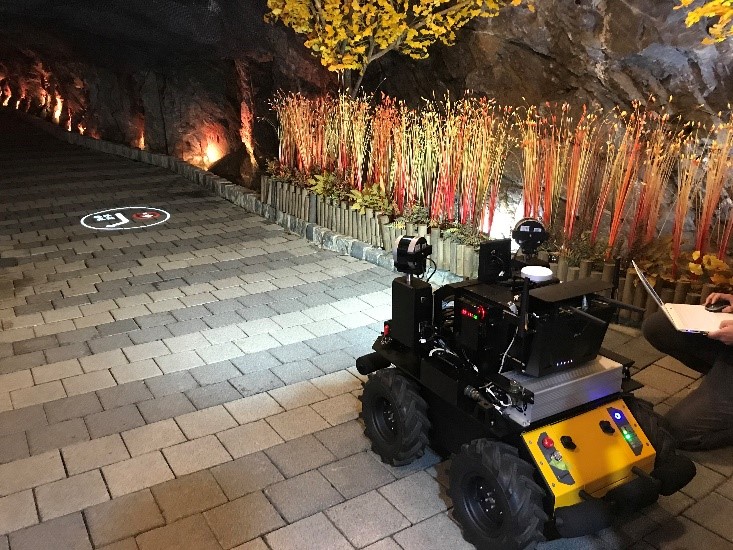
ROBOT OF ALL TRADES: Tunnel reconnaissance robots like this one, co-developed with DARPA, the CCDC Ground Vehicle Systems Center and South Korea to meet the requirements of the 2 ID, are part of an effort aimed at integrating autonomous mapping, data teaming, and chemical, biological, radiological and nuclear sensor capabilities to support subterranean operations. (Photo courtesy of Lt. Col. Michael Sansone, CCDC-Pacific)
CUAS EFFORTS HAVE DEEP ROOTS
CCDC’s international engagement efforts are twofold: International technology centers bring the best of what international industry has to offer, and FAST teams get “shovel-ready” technology out of the labs and into the hands of Soldiers.
CCDC’s counter-unmanned aerial systems (CUAS) efforts have crossed both offices, starting back in 2013. In conjunction with the deputy assistant secretary of the Army for defense exports and cooperation, the CCDC International Technology Center for South Korea established a project agreement on co-development of CUAS technologies. This agreement meant that both the U.S. and South Korean defense researchers would put money and expertise on the table for a collaborative effort to develop CUAS technologies that were capable, producible and interoperable.
Fast forward to 2016, when the 8th Army needed assistance solving its “errant round” problem at Rodriguez Live Fire Complex, South Korea. There, FAST connected the dots to provide a venue for field testing of the radar component of the CUAS project agreement, simultaneously putting a component promised to the South Korean Agency for Defense Development in South Korea for characterization and integration.
The DOD Coalition Warfare Program liked the CUAS project agreement enough to award funding in 2016, which has been further extended through 2020, allowing additional maturation.

NO-RESIDUE SIGNAL: This antenna, used during a wind- and rain-filled demonstration in fall 2019, is capable of sending 600-plus megabits per second in inclement weather, with no residual radio frequency signature. (Picture courtesy of Maj. Bryan Riddle, FAST USAREUR )
TIMING CAN BE EVERYTHING
Inserting a technology into a command’s exercise cycle, often in an overseas command, needs to be sniper-like in its precision. Program offices have failed for overlooking international treaty requirements on exportable technologies or (among other things) electromagnetic spectrum concerns put forth by foreign governments.
Worse, materiel developers have come to commands with last-minute requests to put a prototype system into a multinational tactical exercise (i.e., Defender 2020) that has been intricately planned for months or even years. An Army staff in the spin-up to such a major exercise is already working overtime to execute mission requirements; the prospect of changing in-depth plans or standard operating procedures and swapping out trusted equipment for an unproven prototype is absolutely untenable—unless it was planned in advance.
Enter the FAST office, under CCDC’s G-3, with its experimentation master plan, which lays out named exercises in the coming years, while aligning potential technology insertions with command requirements. CCDC builds the exercise management plan with input from its FAST officers around the world, who have access to exercise calendars, integrated priority lists and general staffs, where they sit daily to learn about a commander’s biggest challenges.
For more information, go to the CCDC webpage at https://www.army.mil/ccdc#org-resources.
LT. COL. MARC MEEKER is the director of the International Technology Center – Northern Europe, with offices at Frankfurt Consulate and Koblenz, where he is co-located with the German Ministry of Defense’s acquisition arm. He most recently wrote for Army AL&T about the international technology centers’ mission worldwide (“International Innovation,” Winter 2020 issue, Page 54). Marcholds an MBA with an acquisition focus from the Naval Postgraduate School and an undergraduate degree in mechanical engineering and design technology from Oklahoma State University. He is Level III certified in program management and an Army Acquisition Corps member. He speaks fluent German, conversational Spanish and passable Japanese.
This article is published in the Summer 2020 issue of Army AL&T magazine.
Subscribe to Army AL&T News – the premier online news source for the Army Acquisition Workforce.
![]() Subscribe
Subscribe







